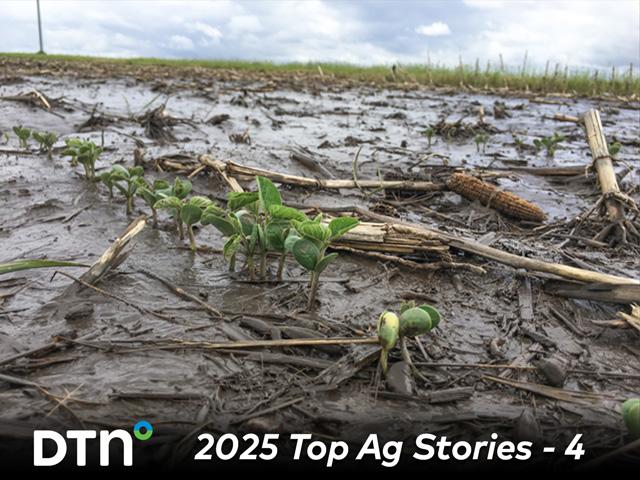Ag Weather Forum
From Flash Droughts to Flooding: The Difference One Year Can Make
Much like other farms in southern Minnesota and northern Iowa right now, my family's farm in southwest Minnesota is dealing with saturated soil and standing water. We are thankful for our field tile but hope the rain becomes less frequent. The situation we are facing on our farm right now is far different from what we were dealing with in June 2023, when we were amid a flash drought.
Looking back at June 2023, parts of southern Minnesota, southern Wisconsin, and northern Iowa had precipitation accumulations approaching 2 to 5 inches below normal. The U.S. Drought Monitor throughout June 2023 showed pockets of moderate and severe drought expanding across southern Minnesota, Iowa, and Wisconsin. In these same areas, the current U.S. Drought Monitor that was released June 20 shows no areas of drought for southern Minnesota and northwest Iowa. There are a few pockets of abnormally dry areas in southern Wisconsin and eastern Iowa, though.
Over the past few weeks, the active weather pattern has brought rounds of heavy rain and thunderstorms to portions of the Western Corn Belt. This active pattern is a result of upper-level troughs from the Canadian Prairies or western United States drifting east, and we haven't been able to get a persistent upper-level ridge to build across the Central U.S. Upper-level ridges often provide dry and fair weather while upper-level troughs are associated with low-pressure systems that lead to precipitation.
P[L1] D[0x0] M[300x250] OOP[F] ADUNIT[] T[]
Last June, El Nino was taking shape across the tropical Pacific Ocean. El Nino is a part of the greater El Nino-Southern Oscillation (ENSO) and El Nino occurs when sea surface temperatures in the tropical East Pacific Ocean are above normal. While El Nino's impacts were not as apparent during the early summer last year, systems were less frequent across the Midwest. Luckily, there were some timely rains later in the growing season which lessened the impacts of drought for some areas.
Currently, neither El Nino nor La Nina conditions are present in the tropical Pacific Ocean. Instead, there are neutral conditions. Neutral conditions occur when sea surface temperatures in the tropical Pacific Ocean are near normal, which is typically around 75 to 80 degrees Fahrenheit. It's hard to say with any confidence that these neutral conditions are playing a significant role in the active weather pattern across the Midwest early this summer. Rather, the more likely scenario comes from the influence of other global weather patterns such as the Pacific Decadal Oscillation (PDO) and the Madden-Julian Oscillation (MJO).
The PDO has both negative and positive phases and these phases are tracked by looking at ocean temperatures and sea level pressures in the north Pacific Ocean and along North America's Pacific Coast. In mid-June, the PDO was in a negative phase, and it was working in conjunction with the MJO to provide the active weather pattern across the Midwest last week. Instead of being a stationary weather pattern, like the PDO, the MJO is a global weather pattern that moves across the tropics. This pattern is tracked by watching clouds, rainfall, winds, and pressure.
While the PDO and MJO worked together, this allowed an upper-level trough to stay near the West Coast of the U.S. The trough led to an active pattern for the Northern Plains and Midwest with multiple storm systems moving across these regions. Additionally, areas of high pressure elsewhere across North America led to some of these systems' fronts stalling out in parts of the Corn Belt. Stalled fronts can lead to flooding if large storms form along the front. This was the case for areas across South Dakota, Minnesota, Iowa, and Wisconsin last week.
As of June 23, accumulated precipitation for the month of June was 6 to 10 inches above normal across southeast South Dakota and southern Minnesota. Parts of the Western Corn Belt are off to a wet start as earlier planted corn will start to enter the silking stage while early planted soybeans will start blooming. On the other hand, the Southern and Eastern Corn Belt could use more precipitation as flash droughts are starting to develop in those areas. Accumulated precipitation amounts across parts of Illinois, Indiana, and Ohio are up to 4 inches below normal for the month of June.
From flooding to flash droughts, many producers across the Corn Belt are experiencing weather extremes right now; however, the weather pattern could remain active through early July. You can read more about that in John Baranick's most recent blog https://www.dtnpf.com/….
To find more weather conditions and your local forecast from DTN, head over to https://www.dtnpf.com/….
Teresa Wells can be reached at teresa.wells@dtn.com
(c) Copyright 2024 DTN, LLC. All rights reserved.




